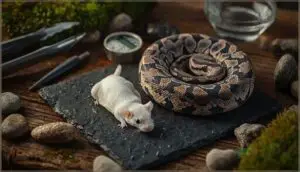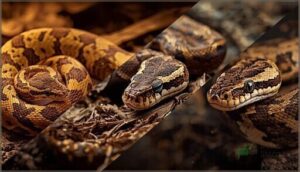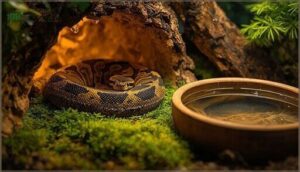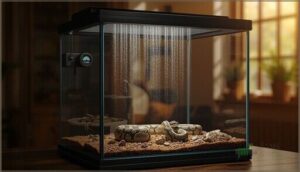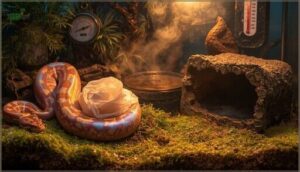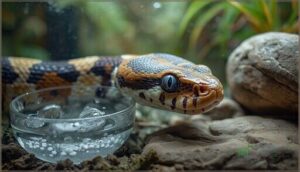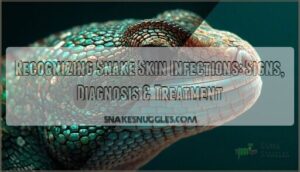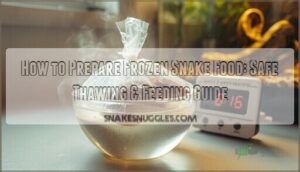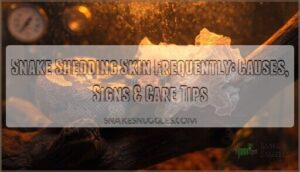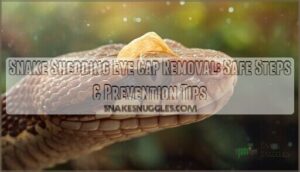This site is supported by our readers. We may earn a commission, at no cost to you, if you purchase through links.
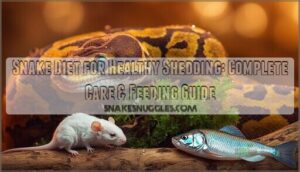
The fat content of a single mouse versus a lean fish can mean extra weeks between healthy molts. Feeding your snake for ideal shedding isn’t about quick fixes. It’s a dance of nutrition, hydration, and timing—one that lets every scale shine when your snake leaves its old skin behind.
Table Of Contents
- Key Takeaways
- Optimizing Snake Diet for Healthy Shedding
- Choosing The Best Prey for Shedding Support
- Feeding Schedules for Different Snake Life Stages
- Creating an Ideal Shedding Environment
- Preventing and Managing Shedding Problems
- Top 3 Products for Healthy Snake Shedding
- Frequently Asked Questions (FAQs)
- Conclusion
Key Takeaways
- Your snake’s diet directly controls shedding success because prey composition—especially the balance of protein for skin structure and fat for lubrication—determines whether your snake completes a clean shed or struggles with stuck skin and dull scales.
- Species-appropriate whole prey items beat commercial alternatives hands-down, with mouse-fed snakes gaining 37 grams more mass than fish-fed snakes over 11 months while delivering the right calcium ratio, metabolic water, and lipid diversity that captive pellets can’t replicate.
- Feeding frequency must adapt to your snake’s life stage and shedding cycle—hatchlings need meals every 4-7 days for rapid growth, adults thrive on 10-21 day intervals, and you should skip feeding 48 hours before visible shedding signs to prevent digestive complications during vulnerable molting periods.
- Environmental factors work in tandem with nutrition to prevent the 30% of stuck sheds caused by husbandry errors, requiring precise humidity control, proper temperature gradients, and species-specific conditions that even a perfect diet can’t compensate for when missing.
Optimizing Snake Diet for Healthy Shedding
Your snake’s diet directly impacts how smoothly it sheds its skin. The right balance of nutrients aids healthy skin regeneration and prevents common shedding problems that can lead to infections or retained shed.
Let’s break down the key dietary factors that’ll keep your snake shedding like a pro.
Importance of Species-Specific Diets
Understanding snake diets starts with matching what your snake would hunt in the wild. Wild prey diets aren’t just tradition—they’re the blueprint for nutritional balance. Captive snakes fed mouse-based diets gained 37 grams more body mass than fish-fed snakes over 11 months, directly improving shed quality. Proper hydration also supports easy shedding.
Here’s why prey item selection matters:
- Nutritional prey diversity mimics nature, rotating rodent types and occasional fish meals for complete nutrition
- Prey lipid content varies dramatically—mice pack over double the body fat of fish
- Metabolic water intake from species-appropriate prey prevents dehydration during shedding
Commercial snake pellets can’t replicate this complexity. Snake nutrition demands whole-prey feeding.
Protein and Fat for Skin Health
Your snake’s skin health depends on getting the right macronutrient balance from its prey rotation. Dietary protein—about 20% of body weight weekly—fuels collagen synthesis and skin renewal. Lipid diversity from varied prey promotes membrane fluidity in shedding cells. Think of it this way: protein builds the structure, fat lubricates the process.
Protein builds your snake’s skin, fat keeps it supple, and both are vital for smooth, healthy shedding
Shedding energy demands both, making nutritional balance non-negotiable for reptile diet success. Carnivorous reptiles, for example, require a diet of whole animal foods to thrive.
Role of Vitamins and Minerals in Shedding
Beyond macronutrients, micronutrients are essential for a snake’s shedding process. Vitamin A deficiency, for instance, can lead to fragile and dull skin, with plasma retinol levels below 0.012 mg/mL indicating potential issues. A balanced 2:1 calcium-to-phosphorus ratio, paired with Vitamin D3 for absorption, is crucial. Hydration minerals like sodium and potassium play a vital role in maintaining skin elasticity, while trace elements such as zinc, manganese, and copper bolster immune defense during vulnerable shedding cycles.
Weekly supplements can address nutritional gaps, especially for snakes on incomplete prey diets, but caution is necessary to avoid toxicity from excess. Here’s a micronutrient checklist to ensure healthy shedding:
- Vitamin A aids epidermal renewal and prevents retained shed
- Calcium Ratio (2:1 with phosphorus) maintains skin integrity
- Hydration Minerals regulate fluid balance for clean separation
- Vitamin D3 promotes calcium absorption from whole prey
- Trace Elements strengthen immunity during shedding stress
A well-balanced diet acts as a snake’s armor against shedding problems. Whole vertebrate prey typically meets most nutritional needs naturally, but captive environments often require targeted supplements, particularly in the absence of UVB exposure. Preventive measures through a balanced diet are far more effective than emergency interventions.
Adjusting Diet Before and During Shedding
When your snake enters pre-shed fasting, don’t panic—it’s nature’s way of reducing digestive risks. During this phase, up to 70% of snakes refuse food, especially during the blue-eyed stage.
If you must feed, downsize prey by one grade and switch to pre-killed options. Live prey becomes dangerous when strike accuracy drops.
Skip feeding 48 hours before visible shedding signs to support a clean, stress-free shed.
Choosing The Best Prey for Shedding Support
Your snake’s prey choices directly impact its ability to shed cleanly and stay healthy. The right food size, type, and preparation method can make the difference between a smooth shed and a frustrating one.
Let’s look at the key feeding decisions that support your snake’s skin health.
Prey Size Selection and Frequency
Getting the right prey size isn’t guesswork—it’s basic physics. Ideal prey should match no more than 1 to 1.5 times your snake’s widest girth to respect gape limitations.
Research shows feeding frequency drops sharply before shedding, especially during the blue-eyed phase. Young snakes experience ontogenetic shifts in prey size selection, while meal digestion timing directly influences shed cycles.
Your milk snake diet and feeding schedule must adapt accordingly.
Mice, Rats, and Alternative Prey Options
Rodents—specifically mice and rats—remain your gold-standard prey items due to their naturally balanced calcium ratio of roughly 1.2:1. A 300-gram adult rat delivers 21% protein and 11% fat, supporting skin regeneration during ecdysis.
Alternative prey like day-old chicks or adult quail offer variety but demand supplementation strategies since they’re calcium-deficient compared to rodents. Prey nutritional value directly impacts shed quality, making rodent calcium ratio your secret weapon.
Benefits of Pre-Killed and Frozen-Thawed Prey
Safety transforms frozen-thawed rodents into your smartest feeding choice. Pre-killed prey eliminates bite injuries that send 22% of live-fed snakes to veterinary hospitals, while freezing at -18°C for 48 hours kills over 95% of parasites.
You’ll see the difference in shedding outcomes—90% of snakes on frozen-thawed diets complete perfect sheds with consistent nutrition and zero handling risks.
Avoiding Common Feeding Mistakes
Overfeeding cuts your snake’s lifespan by 30%, while incorrect prey size causes 41% of feeding fatalities. Don’t feed during shedding—meal acceptance drops 47% anyway.
Space meals properly: hatchlings every 5-7 days, adults every 10-14 days.
For milk snake diet success, match prey size to body width, choose frozen-thawed rodents, and maintain nutritional balance.
Husbandry errors and nutrient deficiencies trigger stuck sheds in over 30% of cases.
Feeding Schedules for Different Snake Life Stages
Your snake’s age determines how often it needs to eat, and getting this right makes all the difference for healthy growth and successful sheds. Young snakes burn through energy fast and need frequent meals, while adults can go longer between feedings without missing a beat.
Let’s break down what each life stage needs so you can create a feeding schedule that keeps your snake thriving.
Hatchlings, Juveniles, and Adult Feeding Needs
Your snake’s age dramatically changes what it needs on the menu. Think of it like fueling different engines—a growing hatchling burns through calories faster than a cruising adult. Here’s what you need to nail down:
- Hatchling diets: Feed pinky mice every 4-7 days to support explosive first-year growth
- Juvenile nutrition: Upgrade to weaned mice every 7-10 days as juveniles reach 60-80% adult size
- Adult feeding: Switch to larger prey every 10-21 days to prevent obesity
- Prey size rule: Match width to your snake’s thickest point—no exceptions
Your feeding schedule directly impacts shed quality.
Seasonal Adjustments and Brumation Considerations
Cold weather flips the script on your feeding schedule. When temperatures drop below 15°C for more than 10 nights, your snake’s metabolic rate plummets by nearly 50%, triggering appetite loss within 48-72 hours.
During brumation, most snakes stop eating completely for 2-4 months—that’s normal. Their fat reserves carry them through, so don’t panic when they refuse meals.
Monitoring Weight and Growth for Shed Health
If your snake’s appetite slows during brumation, it’s time to focus on weight monitoring and BCS assessment. Tracking growth trends and weight fluctuations helps you spot obesity or malnutrition early. I recommend using data tracking sheets to record nutritional status and shed quality. Here’s what to watch:
- Sudden weight drops
- Patchy shed
- Stuck eye caps
- Poor muscle tone
- Rapid mass gain
Creating an Ideal Shedding Environment
Getting your snake’s enclosure just right makes shedding smoother and safer. There are a few key features that can make all the difference. Here’s what to focus on when setting up their space.
Maintaining Proper Humidity and Temperature
With humidity monitoring and temperature gradients dialed in, you’re giving your snake the keys to a smooth shed. Use control tools like digital hygrometers and thermostats to regulate humidity levels and temperature.
Each species has specific needs—ball pythons crave higher humidity, while corn snakes need less. Stable environmental conditions prevent shedding complications and keep your snake thriving.
Providing Humid Hides and Soaking Opportunities
When you’re balancing humidity levels perfectly, don’t underestimate the power of a well-placed humid hide and clean soaking bowl. Most snakes use a humid hide for hydration and stuck shed remediation, choosing sphagnum moss or damp paper towels for consistent moisture. Compare enclosure humidity with these microclimates:
- Humid hide materials boost skin health
- Soaking frequency benefits shed success
- Hide humidity levels outpace ambient air
Safe Enclosure Setup and Ventilation
After nailing humid hide placement, shift your attention to the nuts and bolts of enclosure size and smart ventilation placement. A roomy snake enclosure with mesh vents—spread out for vertical airflow—keeps respiratory issues at bay.
Balanced humidity control and setup safety aren’t optional; they’re your front-line defense against stagnant air, mold, or risky temperature swings that undermine shed cycles.
Environmental Triggers for Successful Shedding
Inside your enclosure, temperature gradients and humidity control set the stage for perfect snake shedding. When you add natural light exposure, a humidity-retentive substrate, and mimic seasonal triggers, you line up every environmental factor for success.
Dial in hydration protocols and steady humidity levels, and your snake will outgrow each skin with the drama of a well-rehearsed escape act.
Preventing and Managing Shedding Problems
Even with the best setup, snakes can run into trouble when it’s time to shed. Knowing the early warning signs and how to respond makes a real difference.
Here’s what to watch for—and what you can do to keep your snake comfortable and healthy.
Identifying Signs of Shedding Issues
Ever notice rough, patchy sheds clinging like old socks, or cloudy eye caps that simply won’t clear? When snakes can’t shed cleanly, you’ll spot:
- Retained shed around the tail or jaw
- Wrinkled, dull eye caps
- Patchy skin peeling in bits
- Lethargy or hiding more often
- Persistent rubbing against surfaces
Catch these early—skin health depends on it.
Hydration and Nutritional Deficiencies
How does a lapse in water or key nutrients show up in your snake’s shed? When Hydration drops, Water Loss soars—suddenly dysecdysis risk climbs. Vitamin Deficiencies and Mineral Imbalances, especially in diets lacking variety, fuel stuck shed and stubborn eye caps.
For healthy snake nutrition, regular Diet Assessment and targeted Supplements and Hydration help keep shedding easy and scales gleaming.
Safe Assistance Techniques for Stuck Shed
Don’t let stuck shed turn into a battle—there’s a smarter way. Gentle soaking, the pillowcase method, or a simple humidity enclosure can loosen stubborn skin (especially along the tail area).
Try shedding aids or a warm compress for tough spots. If manual assistance is needed, focus only on loosened skin and steer clear of retained eye caps; some jobs require true veterinary attention.
When to Seek Veterinary Care
When retained skin clings and lethargy signs linger, it’s time for a veterinary consultation. Watch for infection risks like foul odor or discolored patches, and don’t ignore respiratory issues or persistent dysecdysis.
Veterinary care for snakes isn’t just back-up—it’s essential for real snake health care, catching silent health issues before they spiral into bigger problems.
Top 3 Products for Healthy Snake Shedding
When your snake’s skin starts looking hazy, the right tools can make all the difference. These top products help you create an environment that encourages stress-free, healthy sheds.
Here’s what I recommend for keeping your snake comfortable and shedding on schedule.
1. Professional Aluminum Snake Grabber Handling Tool
A reliable aluminum snake grabber can be the difference between a smooth feeding session and a risky scramble. With grabber material strength that meets industry grabber standards—think all-aluminum alloy—you’re guaranteed safe handling distance whenever you manage prey.
The ergonomic tool design means less hand fatigue while positioning food, essential for large or defensive snakes.
Though prices float near $40, the grabber cost analysis tips in your favor: investing in professional gear keeps both you and your snake safer during every diet routine.
2. Warm Pals Sammy the Snake Plush

Switch gears from steel to soft: Warm Pals Sammy the Snake Plush brings plush therapy benefits straight to your care regimen. Beyond being a sensory comfort toy, it offers microwave safety for heat therapy and lavender aromatherapy to promote calm during routine feeding or shedding checks.
Consumer satisfaction is high, with many families noting improved hydration and reduced stress for young snake keepers. While it’s not a substitute for nutritional balance in snakes, it makes the environment inviting for both handler and pet.
3. New Age Pet Mojave Reptile Lounge
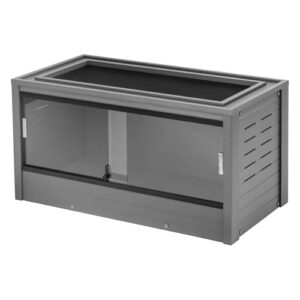
After you’ve ensured comfort in handling, your next step is smart housing. The New Age Pet Mojave Reptile Lounge nails what snakes need for shed-friendly living: ECOFLEX material stands up to moisture, and a well-designed Ventilation Design keeps humidity levels just right for healthy shedding and growth.
Assembly Ease means less hassle for you, while substantial Warranty Coverage and standout Consumer Ratings give peace of mind. This enclosure is a solid ally—combining diet, reptile care, and habitat essentials in one smart package.
Frequently Asked Questions (FAQs)
Can live plants improve shedding and hydration?
Live plants raise humidity levels, creating plant-aided humidity that promotes naturalistic hydration and shedding improvement.
Specific plant species boost environmental stability in your snake’s enclosure, supporting healthy reptile care by balancing hydration and environmental factors for smoother sheds.
How do stress levels affect the shedding cycle?
Like a snake outgrows its skin, stress both pushes and holds back progress. Elevated corticosterone, triggered by environmental stressors, disrupts lymphatic activity and behavioral indicators, leading to delayed or incomplete shedding—even with perfect diet and conditions.
Does snake gender influence shedding frequency or diet?
Gender doesn’t greatly affect shedding frequency or diet in most snakes. Females may shed around reproductive events like egg-laying, while males and females usually shed 1 to 2 times yearly.
Are there shedding risks with wild-caught prey?
Wild-caught prey items open Pandora’s box of problems—parasites hitch a ride, nutritional deficiencies wreak havoc, and contaminant exposure jeopardizes snake health.
Physical injury risks spike, and increased vulnerability during shedding compounds these health issues.
What shedding changes indicate a potential health problem?
Watch for incomplete shedding, retained eye caps, skin discoloration, or fragile shed pieces.
Abnormal frequency—shedding too often or rarely—plus behavioral changes like refusing food signal potential health issues requiring veterinary attention.
Conclusion
Think of your snake’s next shed like a blueprint written in every meal you serve—each prey item lays the foundation for smooth, complete skin renewal.
A well-planned snake diet for healthy shedding isn’t luck; it’s precision nutrition paired with the right environment.
Master the balance of protein, hydration, and timing, and you’ll watch your snake glide out of its old skin effortlessly, scales gleaming like polished armor ready for the next chapter.
- https://talis-us.com/blogs/news/the-ultimate-snake-diet-guide-what-to-feed-your-pet-snake
- https://www.store.repashy.com/vitamin-and-mineral-supplements-breaking-it-down.html
- https://arcadiareptile.com/earthpro/supplements/shedsupport/
- https://www.jstor.org/stable/1436886
- https://scholarworks.uark.edu/etd/4874/

